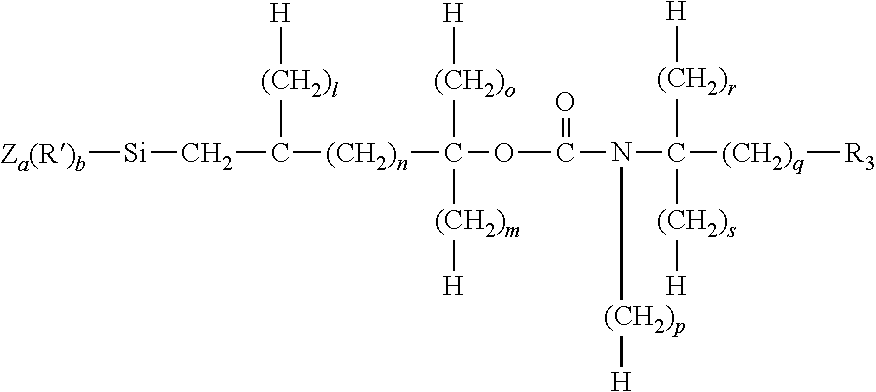Porous hybrid monolith materials with organic groups removed from the surface
a hybrid monolith and organic group technology, applied in the direction of amphoteric ion exchangers, chemical/physical processes, component separation, etc., can solve the problems of polymeric chromatographic materials shrinking and swelling, inadequate separation performance, etc., to improve stability and separation characteristics, reduce surface organic groups, and increase the concentration of bonded phase surfa
- Summary
- Abstract
- Description
- Claims
- Application Information
AI Technical Summary
Benefits of technology
Problems solved by technology
Method used
Image
Examples
example 1
[0142]Pluronic P-105, 21.0 g, was dissolved in 150 mL of a 70 mM acetic acid solution. The resulting solution was agitated at room temperature until all of the Pluronic P-105 was dissolved and was then chilled in an ice-water bath. Meanwhile, methyltrimethoxy-silane (20 mL) and tetramethoxysilane (40 mL) were mixed at room temperature in a separate, sealed flask. The mixed silane solution was slowly added into the chilled acetic acid solution, whereupon the silanes dissolved into the acetic acid solution after a few minutes. The resulting solution was transferred into a series of sealed polypropylene vials (9.6 mm×10 cm), and the vials were kept at 45° C. undisturbed for 2 days. The solid white rods produced were subsequently immersed into a solution of 0.1 N aqueous ammonium hydroxide solution for 3 days at 60° C. The monolith rods were then rinsed with water for 2 days, where the water was replaced every 2 hours for an 8 hour daytime period and then allowed to sit overnight. The w...
example 2
[0143]Pluronic P-123, 21.0 g, was dissolved in 150 mL of a 100 mM acetic acid solution. The resulting solution was agitated at room temperature until all of the Pluronic P-123 was dissolved and was then chilled in an ice-water bath. Meanwhile, bis(trimethoxysilyl)ethane (20 mL) and tetramethoxysilane (50 mL), were mixed at room temperature in a separate, sealed flask. A 60 mL portion of the mixed silane solution was slowly added into the chilled acetic acid solution, whereupon the silanes dissolved into the acetic acid solution over 30 minutes. The resulting solution was transferred into a series of sealed polypropylene vials (9.6 mm×10 cm), and the vials were kept at room temperature undisturbed for 30 hours. The solid white rods produced were subsequently immersed into a solution of 0.1 N aqueous ammonium hydroxide solution for 3 days at 60° C. The solid white rods was subsequently immersed into a second solution of 0.1 N aqueous ammonium hydroxide solution for 16 hours at 90° C. ...
example 3
[0144]Triton X-100, 25.0 g, was dissolved in 100 mL of a 15 mM acetic acid solution. The resulting solution was agitated at room temperature until all of the Triton X-100 was dissolved and was then chilled in an ice-water bath. Meanwhile, (3-methacryloxypropyl)trimethoxysilane (10 mL) and tetramethoxysilane (40 mL), were mixed at room temperature in a separate, sealed flask. A 40 mL portion of the mixed silane solution was slowly added into the chilled acetic acid solution, whereupon the silanes dissolved into the acetic acid solution over 60 minutes. The resulting solution was transferred into a series of sealed polypropylene vials (9.6 mm×10 cm). The vials were kept at room temperature undisturbed for 1 hour at room temperature and then were heated to 45° C. for 90 hours. The solid white rods produced were subsequently immersed into a solution of 0.1 N aqueous ammonium hydroxide solution for 1 day at 60° C. The monolith rods were then immersed in water at room temperature for 3 ho...
PUM
| Property | Measurement | Unit |
|---|---|---|
| specific surface area | aaaaa | aaaaa |
| specific surface area | aaaaa | aaaaa |
| interior area | aaaaa | aaaaa |
Abstract
Description
Claims
Application Information
 Login to View More
Login to View More - R&D
- Intellectual Property
- Life Sciences
- Materials
- Tech Scout
- Unparalleled Data Quality
- Higher Quality Content
- 60% Fewer Hallucinations
Browse by: Latest US Patents, China's latest patents, Technical Efficacy Thesaurus, Application Domain, Technology Topic, Popular Technical Reports.
© 2025 PatSnap. All rights reserved.Legal|Privacy policy|Modern Slavery Act Transparency Statement|Sitemap|About US| Contact US: help@patsnap.com



